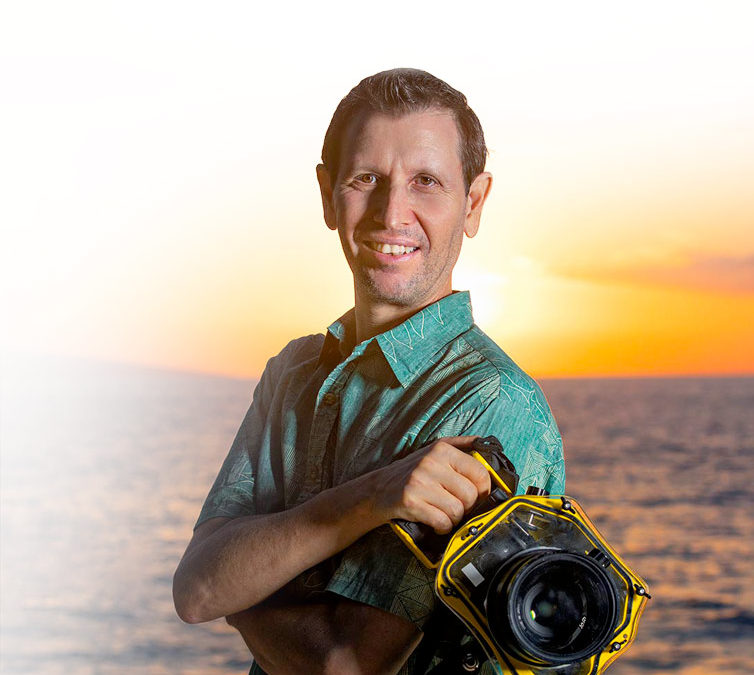March 22, 2021. Wailuku, Maui. Moses lets us get to know a little more about his professional aspirations, life, and what makes him tick.
Nikon or Canon Canon?
Canon, but actually, depending on the job or use, whatever tool is needed.
What’s your favorite lens?
600mm. I like that it’s a telephoto lens—it’s a prime lens. It basically just compresses everything so it makes things from far look up and close. If you’re trying to capture action shots—plus I’ve just always been really good with it.
Favorite color?
I’ve been asked this a lot…and honestly, I’ve learned to love all colors just because all colors are beautiful. There’s not one that stands out more than the other.
Why do you take pictures?
It’s kind of a legacy thing. Creating images for people to have on the walls for a lifetime if not more. Most images I take are going to last longer than the people I know and will be generational.
So to be able to create something for their grandchildren, their children, their children’s children—to know where your heritage is from is a beautiful thing. That includes all aspects of photography, not just portraits or weddings.
It could be a wave or it could be a bird going extinct. If you’ve got something of that nature or even someone that passes by—just to create a moment is a great thing.
What’s your favorite time of day to shoot?
Sunrise or sunset normally, but whenever is available. There’s no certain time in photography to shoot. It’s kind of like you won’t always want to create something and you never know exactly when it’s going to be. Sometimes that high shadow at noon is what the photo is missing.
What was one of your greatest experiences as a photographer?
Probably one of my first pictures. My grandma had Parkinson’s, and we were in Mexico City because that’s where she lived. And to see my mom take care of her at my aunt’s house in Mexico. It was something pretty awesome.
To be able to work with the rolling of 35 millimeter in black and white negative in the dark room—to put it in my camera, to process it, to get behind the printer and develop it and smell the chemicals of it and learn all these little tricks and nuances to what photography can be—is what opened my eyes and it caught a moment in my life that I still have the image, and it’s pretty epic to me.
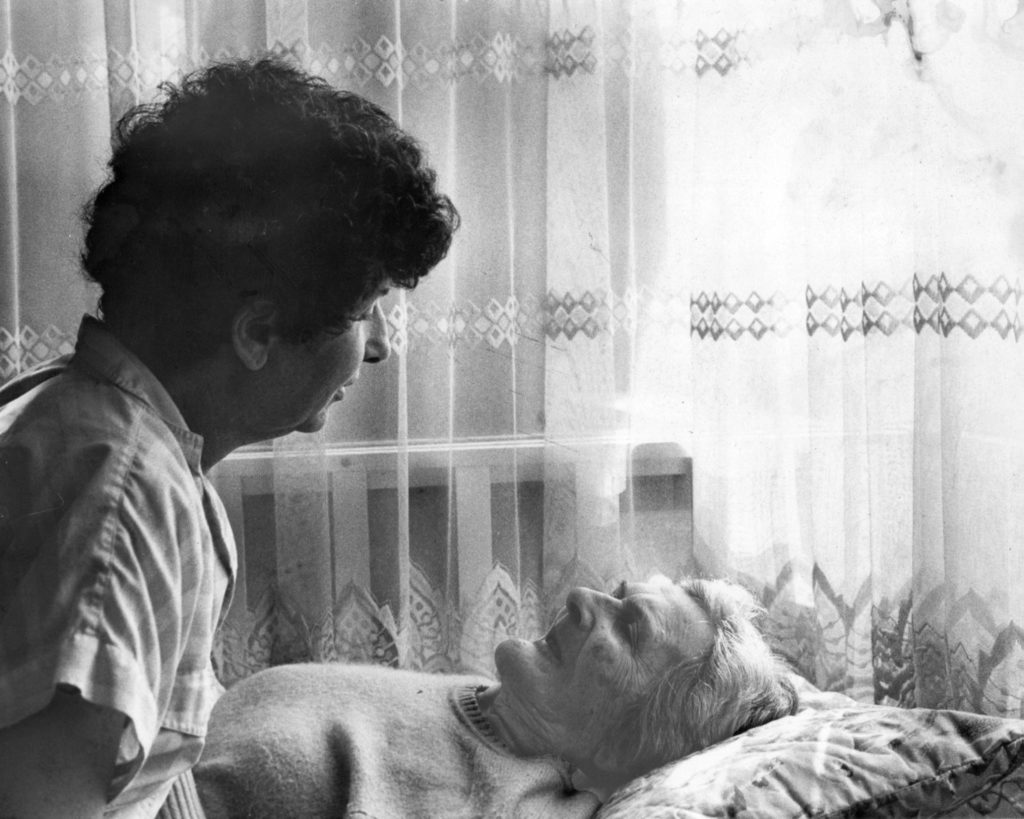
What do you like about your work?
The process. A lot of people just like to shoot photos, which is great, but for me, it’s everythig. It used to be 10 hours in a dark room. Now it’s 10 hours behind the computer.
I like every thing from processing the digital image to creating what I visually see. That could be stunning or just a solid image, so I love the process besides taking the picture.
Do you miss the process of having to develop the old school way?
I don’t miss it because I’m still involved with it. Most of what I shot was with slide film. I have probably over half a million images. So right now I’m in the process of sending those to my friend John who is going to develop them for me onto digital, so I’ll be able to work with those again. And just doing it in different ways of that whole process is still pretty epic.
To be able to go through the loupe and put it on a light table and see which image is gonna look best or what I might use for for sale or just for personal memorabilia. It’s pretty cool.
What inspires you?
Other photographers inspire me. Geographically—locations where they’re at is something I can’t achieve, you know. It’s like if you are in Arizona and you want to get pictures of Antelope Canyon. I can’t go there every weekend to take pictures of Antelope Canyon.
Or if they’re in Australia taking pictures of The Box or or wherever they may be, seeing other photographers trying to achieve the same goals as I am—to create a life lasting image—is pretty inspiring for me.
And as far as what else inspires me is this pandemic. We don’t know how much time we have [alive], so might as well take advantage of the time.
How has your craft changed over time?
Well, I went from a 110, which was a little camera about an inch and a half thick by about seven inches wide. The film was probably the size of your pinky nail. That was my first camera. I was eight years old.
And then at 13, I got my first 35 millimeter camera. Living in San Diego at the time, there was a big skate scene, so I would go across the street to the surf shop and take pictures of my friends skating. Then they started building ramps and quarter pipes in the backyard and started launching.
And then my brother started surfing and he started dragging me along, and it was just like, “Ok I’m going to get pictures of my older brother surfing.” And then all of a sudden it’s just like, “Well, that guy is much better than my older brother surfing.” So I want to get pictures of him and see if I could bring that stoke to him.
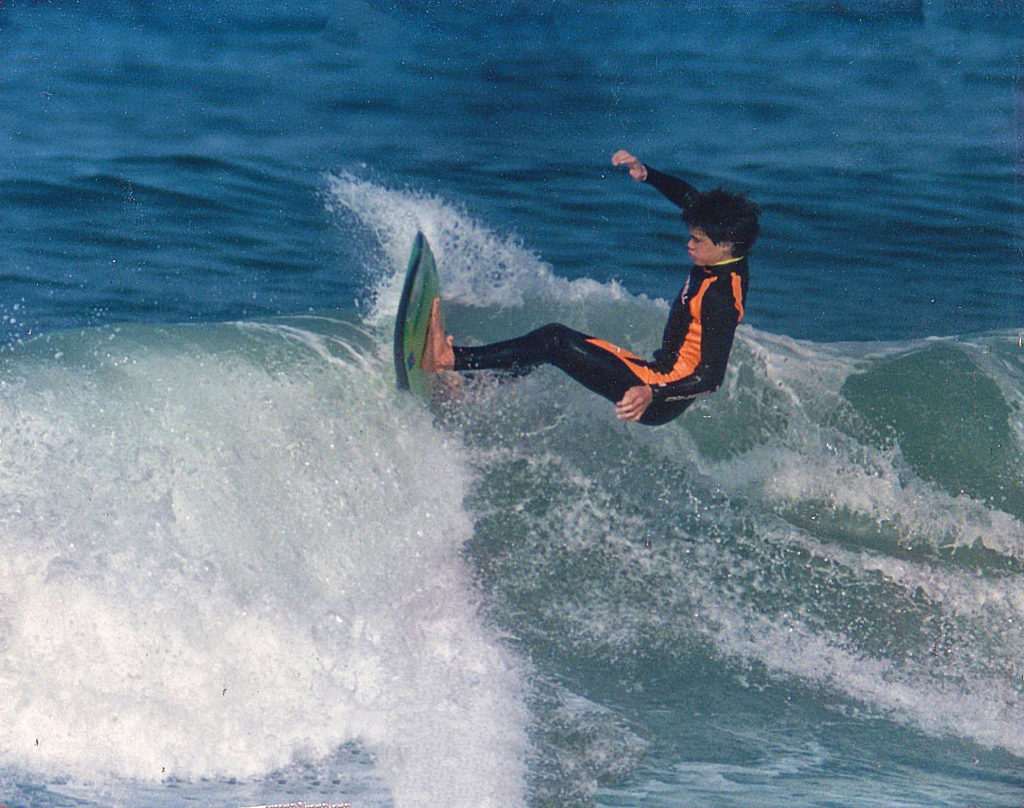
A photo of a friend for the wall in Tijuana. Shot off of the Imperial Beach Pier, San Diego, California. 1987.
So, just the whole process. It’s gone from little bitty negative to medium format to large format. I’ve worked with almost all of them. To look at things upside down and backwards and bring something upright and forward is interesting in itself.
What do you want people to know about your work?
Honestly, whatever brings happiness to them. You know, it’s moving someone, evoking emotion. It is a wonderful thing from something that you create.
Some people are gonna love it, some people are going to be indifferent, some are going to hate it, but as long as I know that I’m doing the best I can, that’s all I’m trying to do.
What’s your dream project?
My dream project would be getting my Master’s Degree in photography. That’s going to take me about a year and a half more. It’s time consuming, but well worth it—I want to get that degree.
What are some of your professional goals for 2021 and 2022?
Just take more pictures. You know, just really like everyone says and like I used to do. I don’t do it anymore because I’ve learned quite a bit. But it’s really the only way to create images.
I was listening to this gentleman, his name is Dennis Hammond. He’s a master photographer and phenomenal nature photographer. And what he said is, if you can get 12 amazing photographs in one year, you’re doing good.
So if I can get 6 to 8 this year and 12 next year that are absolutely mind blowing, I’d be happy.
Who are some of your heroes?
My brother Nathan’s one of my heroes. Just the adversity that he’s gone through in his life, but also achieving the goals that he’s wanted to achieve, creating a great family.
My heroes are my friends that have kids. I think it’s pretty pretty darn cool to see them growing up and doing the same things that we love to do as kids.
Favorite movies?
Um…dumb ass movies, man! I like Dumb and Dumber and Talladega Nights and Step Brothers, and vote for Pedro, um, Napoleon Dynamite. Any of those stupid movies just because they’re so damn stupid. But my all time, probably serious movie that I liked as a kid was Chariots of Fire, that was cool. A war movie with inspiration behind it.
What makes you angry?
I try not to get angry. To be honest with you, I’m pretty even keel and I try not to manifest anger. I just try to deal with the situation. Grow from it.
I get upset sometimes for sure, like everybody. But life’s too short to be angry. I’ve had too much shit happen in my life to worry about all that crap. If it’s not really going to change my life then it’s nothing to worry about.
What’s something you wouldn’t want to do without?
Doctors. And they don’t have to be from western medicine. They could be Chinese, Indian, whatever kind of medicine that could heal you from acupuncture to chiropractors to misuses to dietitians. I would not want to do without them.
What’s the best piece of advice you’ve been given?
Follow the process.
Favorite childhood memory?
When I was 15, I was really, really shy, but I was already taking surfing pictures and I wanted to get recognized. The only way I thought I could get recognized was with my own peers.
So I went down to my friend in Tijuana who owned a club and I said, “If I could put my pictures up on your wall, people would be able to recognize who they are, and they would want to come and check out their surf pictures on your walls, and they could drink and eat and do whatever.”
He said, “Let’s do it.”
So that turned into a lot of parties and good times. And then I came up with the idea of $5 all you can drink beer and tequila which ended up spreading across all of Mexico. A lot of people don’t know that about me. It’s a custom in Mexico now, but before that it used to be two beers for a dollar. That was a total Moses creation.
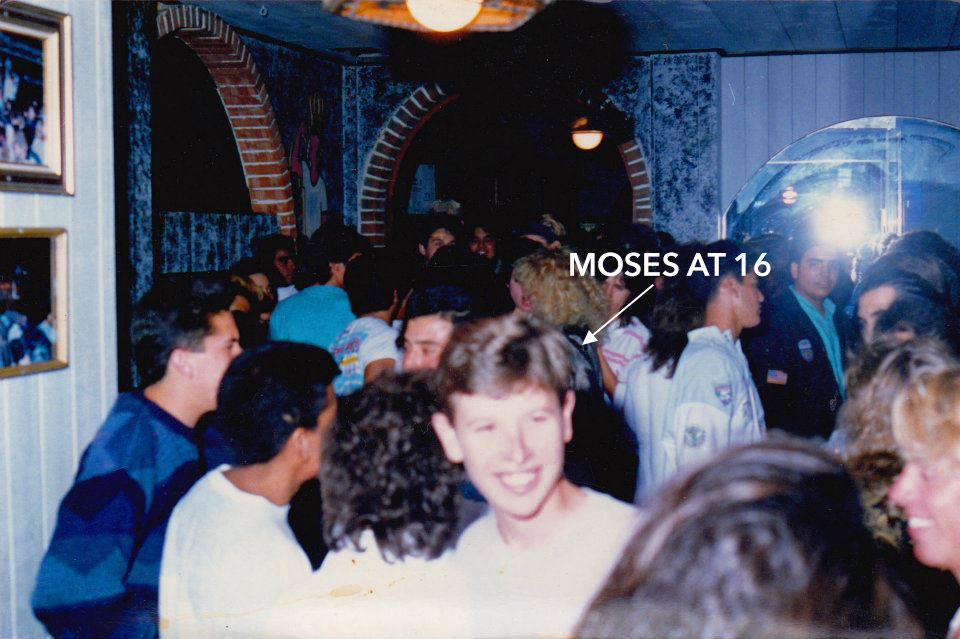
Moses working as a teen at Mr. Crowns, a popular night club in Tijuana, Mexico.
Where are you originally from?
I was born in San Diego and raised between Tijuana and San Diego. In the afternoons after I finished kindergarten and all the way till I was 12, I was going to Hebrew Day school in Tijuana.
So it was like, learn English, learn Hebrew, learn Spanish. But we were speaking Spanish at home.
How did your family emigrate to the US?
If this is correct, and I’m not 100% sure it is correct, these are just some of the stories I’ve heard, but right before World War II, the U.S. wasn’t allowing any more immigrants in, so my grandparents ended up going to Mexico.
They came from Slovakia, Czech Republic, Russia, and I believe Lithuania between those countries.
Why did you choose to live in Hawaii?
I started doing a lot of traveling and met up with a lot of great surfers—some of the best surfers in the world. I wanted to find the direction I wanted to go in as far as for photography.
California’s great, but I was driving everywhere and traveling everywhere, and there was really no consistency to my life. There’s nothing wrong with it, but after doing it for about eight years, it just got a little bit old. You get older and you just want something a little more consistent.
In Hawaii, you have the best surfers for the last 25 years coming back every year, it’s nonstop—like as soon as you hear the theme song from the NFL, the winter season’s on and the swells just hit.
So, to be able to be in one spot for at least six months to seven months out of the year—to be able to shoot surf consistently. And then if I want to go to the South Shore, I could do that as well, to continue shooting for a few extra months.
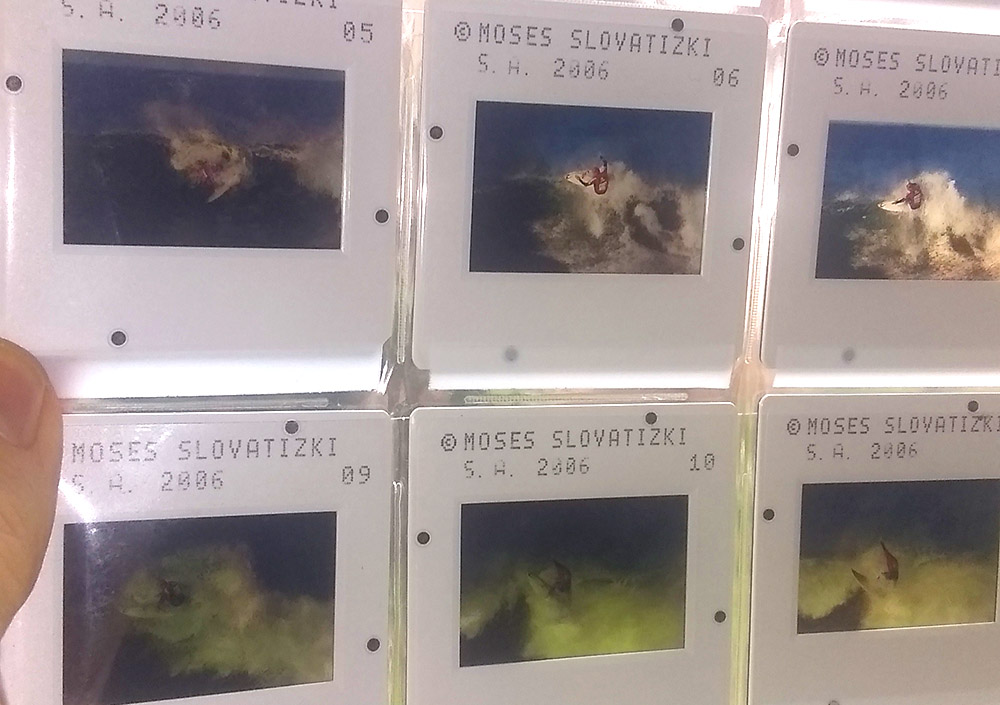
I’ve always loved it, you know. I moved to Maui when I first got out here, and I lived out here for two years and then I moved to O’ahu for a year and a half.
Before I moved out here, my friend Erica, she is a great friend from Imperial beach, California, got a job at an airline and she would hook me up with buddy passes. So it cost me $150 round trip to get from LAX to Hawaii and I could always change my dates, so going for a week ended up being a month and a half.
There was no extra charge and I would just couch surf. And you get to that certain age where you ask yourself, where do you want home to be?
Yeah, 16 years later, I’m still here in Hawaii.
Any advice for young aspiring photographers out there?
Just shoot photos—really, shoot photos. The great thing about digital is you can make mistakes and you can also create a great composition and learn how to create composition a lot faster.
Expose for your highlights, not your shadows. The difference between film and digital is that in film you always used to expose for shadows and in digital you expose for the highlights. That way your whites aren’t completely blown out and your blacks aren’t completely black—because a lot of people get that. But there are details to both.
If you look at a white T shirt on a person, it’s still a white T shirt, but you can still see the wrinkles on that white T shirt. So make sure you just don’t over expose it and lose that detail because it’s really unflattering. So, expose for those and just shoot as much as possible.
And then once you’re ready, really focus on one or two things that you want to shoot because, as I’m learning, you can’t be an expert in all of them. If you want to sell your photography, you can sell it, but it’s going to have to be that one thing.
So shoot, shoot, shoot and ask questions. And it’s okay to make mistakes because the next time you could do the opposite.

